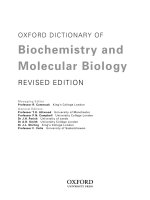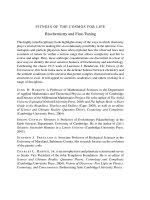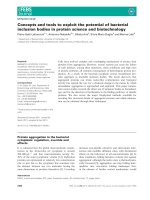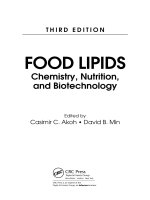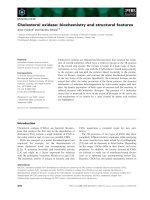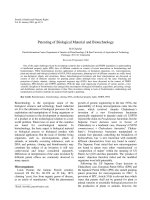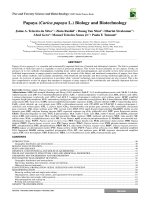Algae anatomy, biochemistry, and biotechnology
Bạn đang xem bản rút gọn của tài liệu. Xem và tải ngay bản đầy đủ của tài liệu tại đây (40.49 MB, 344 trang )
Tai Lieu Chat Luong
ALGAE
A N ATO M Y, B I O C H E M I S T RY,
A N D B I OT E C H N O LO G Y
SECOND EDITION
ALGAE
A N ATO M Y, B I O C H E M I S T RY,
A N D B I OT E C H N O LO G Y
SECOND EDITION
L AURA BARSANTI • PAOLO GUALTIERI
Istituto di Biofisica
Pisa, Italy
CRC Press
Taylor & Francis Group
6000 Broken Sound Parkway NW, Suite 300
Boca Raton, FL 33487-2742
© 2014 by Taylor & Francis Group, LLC
CRC Press is an imprint of Taylor & Francis Group, an Informa business
No claim to original U.S. Government works
Version Date: 20130827
International Standard Book Number-13: 978-1-4398-6733-4 (eBook - PDF)
This book contains information obtained from authentic and highly regarded sources. Reasonable efforts have been
made to publish reliable data and information, but the author and publisher cannot assume responsibility for the validity of all materials or the consequences of their use. The authors and publishers have attempted to trace the copyright
holders of all material reproduced in this publication and apologize to copyright holders if permission to publish in this
form has not been obtained. If any copyright material has not been acknowledged please write and let us know so we may
rectify in any future reprint.
Except as permitted under U.S. Copyright Law, no part of this book may be reprinted, reproduced, transmitted, or utilized in any form by any electronic, mechanical, or other means, now known or hereafter invented, including photocopying, microfilming, and recording, or in any information storage or retrieval system, without written permission from the
publishers.
For permission to photocopy or use material electronically from this work, please access www.copyright.com (http://
www.copyright.com/) or contact the Copyright Clearance Center, Inc. (CCC), 222 Rosewood Drive, Danvers, MA 01923,
978-750-8400. CCC is a not-for-profit organization that provides licenses and registration for a variety of users. For
organizations that have been granted a photocopy license by the CCC, a separate system of payment has been arranged.
Trademark Notice: Product or corporate names may be trademarks or registered trademarks, and are used only for
identification and explanation without intent to infringe.
Visit the Taylor & Francis Web site at
and the CRC Press Web site at
Alla Lilli, perché è sempre la mia mamma, anche se mi fa diventare
matto come quando ero piccino [(ti voglio bene, mamma!)]
Paolo
To my mom, Silvana (1926–2008), and my dad, Renzo (1928–2009),
because I know they are still watching over me, and to Bernard
(1952–2011) pour son voyage en solitaire (nakupenda tarepanda)
Laura
Contents
Preface............................................................................................................................................ xiii
Authors.............................................................................................................................................. xv
Chapter 1 General Overview......................................................................................................... 1
Definition.......................................................................................................................1
Classification................................................................................................................. 2
Occurrence and Distribution......................................................................................... 2
Structure of Thallus—Cytomorphological Types.........................................................6
Unicells and Unicell Colonial Type.........................................................................8
Filamentous Type................................................................................................... 10
Siphonocladous Type.............................................................................................. 13
Siphonous Type...................................................................................................... 13
Parenchymatous and Pseudo-Parenchymatous Type............................................. 14
Palmelloid Type...................................................................................................... 15
Nutrition...................................................................................................................... 16
Reproduction............................................................................................................... 17
Vegetative and Asexual Reproduction.................................................................... 17
Binary Fission or Cellular Bisection.................................................................. 17
Zoospore, Aplanospore, and Autospore............................................................ 18
Autocolony Formation....................................................................................... 18
Fragmentation.................................................................................................... 18
Resting Stages.................................................................................................... 18
Sexual Reproduction...............................................................................................20
Haplontic or Zygotic Life Cycle.........................................................................20
Diplontic or Gametic Life Cycle........................................................................20
Diplohaplontic or Sporic Life Cycles................................................................20
Summaries of the 11 Algal Phyla................................................................................ 22
Cyanobacteria......................................................................................................... 22
Glaucophyta............................................................................................................24
Rhodophyta............................................................................................................25
Chlorophyta............................................................................................................ 29
Charophyta............................................................................................................. 32
Haptophyta............................................................................................................. 33
Cryptophyta............................................................................................................ 35
Ochrophyta............................................................................................................. 35
Cercozoa—Chlorarachniophyceae......................................................................... 39
Myzozoa—Dinophyceae........................................................................................ 39
Euglenozoa—Euglenophyceae............................................................................... 41
Endosymbiosis and Origin of Eukaryotic Photosynthesis.......................................... 42
Suggested Reading......................................................................................................46
Chapter 2 Anatomy...................................................................................................................... 49
Cytomorphology and Ultrastructure........................................................................... 49
Outside the Cell...................................................................................................... 49
vii
viii
Contents
Type 1—Simple Cell Membrane....................................................................... 49
Type 2—Cell Surface with Additional Extracellular Material......................... 50
Type 3—Cell Surface with Additional Intracellular Material
in Vesicles..........................................................................................................60
Type 4—Cell Surface with Additional Extracellular and Intracellular
Material.............................................................................................................. 62
Flagella and Associated Structures........................................................................66
Flagellar Shape and Surface Features............................................................... 68
Flagellar Scales.................................................................................................. 68
Flagellar Hairs................................................................................................... 70
Flagellar Spines................................................................................................. 72
Internal Features of the Flagellum......................................................................... 72
Axoneme............................................................................................................ 72
Paraxial Rod...................................................................................................... 73
Other Intraflagellar Accessory Structures......................................................... 74
Transition Zone.................................................................................................. 75
Basal Bodies...................................................................................................... 79
Root System....................................................................................................... 82
How Algae Move.................................................................................................... 93
Swimming......................................................................................................... 93
Movements Other than Swimming....................................................................99
Buoyancy Control............................................................................................ 100
How a Flagellum Is Built: The Intraflagellar Transport.................................. 102
How a Flagellar Motor Works......................................................................... 103
How a Paraxial Rod Works............................................................................. 104
The Photoreceptor Apparata................................................................................ 104
Types of Photoreceptive Systems.............................................................................. 106
Type I.................................................................................................................... 106
Type II.................................................................................................................. 108
Type III................................................................................................................. 109
Photoreceptive Proteins........................................................................................ 111
Fundamental Behavioral and Physiological Features.......................................... 111
Sampling Strategies......................................................................................... 112
Trajectory Control............................................................................................ 113
Signal Transmission......................................................................................... 114
An Example: Photoreceptor and Photoreception in Euglena............................... 114
Chloroplasts..................................................................................................... 118
The Nucleus, Nuclear Division, and Cytokinesis............................................ 126
Ejectile Organelles and Feeding Apparata...................................................... 132
Suggested Reading.................................................................................................... 137
Chapter 3 Photosynthesis........................................................................................................... 141
Light.......................................................................................................................... 141
Photosynthesis........................................................................................................... 144
Light-Dependent Reactions....................................................................................... 145
PSII and PSI: Structure, Function, and Organization.......................................... 153
ATP Synthase....................................................................................................... 155
ETC Components................................................................................................. 155
Electron Transport: The Z-Scheme...................................................................... 157
Proton Transport: Mechanism of Photosynthetic Phosphorylation...................... 158
Contents
ix
Pigment Distribution in PSII and PSI Super-Complexes of Algal Division........ 160
Light-Independent Reactions..................................................................................... 160
RuBisCO............................................................................................................... 166
Calvin–Benson–Bassham Cycle........................................................................... 167
Carboxylation....................................................................................................... 167
Reduction.............................................................................................................. 167
Regeneration......................................................................................................... 167
Photorespiration.................................................................................................... 168
The Energy Relationships in Photosynthesis: The Balance Sheet............................ 168
Suggested Reading.................................................................................................... 170
Chapter 4 Working with Light................................................................................................... 173
How Light Behaves................................................................................................... 173
Scattering.................................................................................................................. 173
Absorption................................................................................................................. 174
Interference............................................................................................................... 175
Reflection................................................................................................................... 175
Refraction.................................................................................................................. 177
Dispersion.................................................................................................................. 178
Diffraction................................................................................................................. 178
Field Instruments: Use and Application.................................................................... 181
Radiometry................................................................................................................ 181
Measurement Geometries: Solid Angles................................................................... 181
Radiant Energy.......................................................................................................... 182
Spectral Radiant Energy........................................................................................... 182
Radiant Flux (Radiant Power)................................................................................... 182
Spectral Radiant Flux (Spectral Radiant Power)...................................................... 182
Radiant Flux Density (Irradiance and Radiant Exitance)......................................... 182
Spectral Radiant Flux Density.................................................................................. 183
Radiance.................................................................................................................... 183
Spectral Radiance..................................................................................................... 184
Radiant Intensity....................................................................................................... 184
Spectral Radiant Intensity......................................................................................... 185
Photometry................................................................................................................ 185
Luminous Flux (Luminous Power)........................................................................... 185
Luminous Intensity................................................................................................... 185
Luminous Energy...................................................................................................... 188
Luminous Flux Density (Illuminance and Luminous Exitance).............................. 188
Luminance................................................................................................................. 188
Lambertian Surfaces................................................................................................. 188
Units Conversion....................................................................................................... 189
Radiant and Luminous Flux (Radiant and Luminous Power).............................. 189
Irradiance (Flux Density)..................................................................................... 190
Radiance............................................................................................................... 190
Radiant Intensity.................................................................................................. 190
Luminous Intensity............................................................................................... 190
Luminance............................................................................................................ 190
Geometries........................................................................................................... 190
PAR Detectors........................................................................................................... 191
The Photosynthesis–Irradiance Response Curve (P vs. E Curve)............................ 193
x
Contents
Photoacclimation....................................................................................................... 196
Suggested Reading.................................................................................................... 197
Chapter 5 Biogeochemical Role of Algae.................................................................................. 199
The Role of Algae in Biogeochemistry..................................................................... 199
Limiting Nutrients.....................................................................................................200
Algae and the Phosphorus Cycle...............................................................................202
Algae and the Nitrogen Cycle...................................................................................204
Algae and the Silicon Cycle......................................................................................209
Algae and the Sulfur Cycle....................................................................................... 212
Algae and the Oxygen–Carbon Cycles..................................................................... 214
Suggested Reading.................................................................................................... 218
Chapter 6 Algal Culturing......................................................................................................... 221
Collection, Storage, and Preservation....................................................................... 221
Culture Types............................................................................................................224
Culture Parameters.................................................................................................... 226
Temperature.......................................................................................................... 227
Light..................................................................................................................... 227
pH......................................................................................................................... 227
Salinity................................................................................................................. 227
Mixing.................................................................................................................. 228
Culture Vessels.......................................................................................................... 228
Media Choice and Preparation.................................................................................. 229
Freshwater Media................................................................................................. 230
Marine Media....................................................................................................... 230
Seawater Base............................................................................................................240
Nutrients, Trace Metals, and Chelators..................................................................... 241
Vitamins.................................................................................................................... 243
Soil Extract................................................................................................................244
Buffers.......................................................................................................................244
Sterilization of Culture Materials............................................................................. 245
Culture Methods........................................................................................................ 252
Batch Cultures...................................................................................................... 253
Continuous Cultures............................................................................................. 255
Semicontinuous Cultures...................................................................................... 256
Commercial-Scale Cultures................................................................................. 257
Outdoor Ponds........................................................................................................... 257
Photobioreactors........................................................................................................ 259
Culture of Sessile Microalgae.............................................................................. 259
Quantitative Determinations of Algal Density and Growth.....................................260
Growth Rate and Generation Time Determinations............................................264
Suggested Reading.................................................................................................... 265
Chapter 7 Algae Utilization....................................................................................................... 267
Introduction............................................................................................................... 267
Sources and Uses of Algae........................................................................................ 268
Human Food......................................................................................................... 268
Contents
xi
Cyanobacteria.................................................................................................. 268
Rhodophyta...................................................................................................... 271
Ochrophyta (Phaeophyceae)............................................................................ 274
Chlorophyta..................................................................................................... 279
Animal Feed......................................................................................................... 282
Extracts................................................................................................................. 286
Agar................................................................................................................. 287
Alginates.......................................................................................................... 288
Carrageenan..................................................................................................... 289
Fertilizers.............................................................................................................. 291
Cosmetics.............................................................................................................. 293
Functional Foods and Nutraceuticals........................................................................ 294
Toxins................................................................................................................... 301
Selected Reading....................................................................................................... 305
Chapter 8 Oddities and Curiosities in the Algal World.............................................................309
In the Realm of Darkness..........................................................................................309
Algae–Animal Interaction: Riding a Sloth, Swinging on a Spider Web,
Swimming in a Jelly . . .............................................................................................. 314
Some Like It Cold . . ................................................................................................. 320
Some Like It Hot . . ................................................................................................... 322
Some Like It Dry . . .................................................................................................. 324
Selected Reading....................................................................................................... 325
Preface
In the seven years since the first edition of this book was published, we have built up a large amount
of new material and data in the field of algology, based on our own experiences in reading, writing,
and reviewing. With the aid of all this information, we have completely revised the book, introducing the following changes and additions:
•
•
•
•
•
•
•
•
•
•
•
We have added 27 new figures for a total of 205 figures, many of them in color
All the 38 tables have been revised and rewritten
We have updated the literature in all chapters
We wrote an entirely new chapter on how odd algae can be
We have rewritten Chapter 1, updating the classification of algae and modifying the section
on the endosymbiosis and origin of eukaryotic photosynthesis
We have expanded Chapter 2, adding new types of root systems and algal swimming patterns and modifying the section on photoreception and photoreceptors
We have updated Chapter 3, adding absorption spectra measured on samples from all algal
divisions together with their decomposition in pigments. We have also added the absorption spectra of all the chlorophylls and the accessory pigments
We have modified notation and wording of Chapters 4 and 5
We have expanded section on collection storage and preservation in Chapter 6, adding new
information on automatic algae recognition and classification
We have rewritten Chapter 7, updating the section on algal toxins and algal bioactive
molecules
We have, of course, corrected the numerous errors present in the first edition (we do apologize for them), doing our best to avoid errors in this new edition
Like the previous edition, this book is written and designed for undergraduate and postgraduate
students with a general scientific background, having their first academic experience with the world
of algae, as well as researchers, teachers, and professionals in the field of phycology and applied
phycology. Our major commitment is still the same, challenging and stimulating both students and
teachers to move beyond the limit of the written page to further explore not only the topics highlighted in the book, but also all the new ideas that can spring to mind (we hope!) after reading each
chapter.
Though updated, the bibliography is still by no means exhaustive; we have not attempted to be
comprehensive and many excellent papers will be missing. Our intention was to put in only enough
to lead the readers into the right part of the primary literature in a fairly directed manner and to
provide a sort of orienteering compass in the “mare magnum” of scientific literature.
We are deeply grateful to the staff at CRC Press, Boca Raton, FL, particularly our patient and
comprehensive editor John Sulzycki for trusting us enough to ask for a second edition and to the
senior project coordinator Jill Jurgensen, who had to cope with all our e-mail.
Again, our sincere gratitude and a special thanks to Valter Evangelista for his skillful assistance
and ability in preparing the final form of all the drawings and illustrations, and for his careful attention in preparing all the technical drawings of this second edition. We appreciate his efforts to keep
pace with us both and to cope with our ever-changing demands and corrections and second thoughts
without getting too upset. We know we have driven him crazy.
And we will always be grateful to Vincenzo Passarelli, who took care of the lab, making our
work lighter and smoother. Next February he will retire, leaving our group after more than 30 years;
xiii
xiv
Preface
we have grown old together and we already know we will miss his smile, and his special trumpetlike whistling.
For the new illustrations present in the book, we are indebted to Luca Barsanti, brother of Laura
and Maria Antonietta, who succeeded in realizing most of the drawing of our book before dying in
February 2005. He made the drawing work in a wonderful way, confirming his artistic skill. Though
almost eight years have passed by, and some snow has also fallen on his roof, he is still the same
light-hearted and amusing company who delighted us during the preparation of the first edition. We
will be always grateful to him.
Authors
Dr. Paolo Gualtieri graduated in biology and computer science from University of Pisa, Italy. At
present, he is senior scientist at the Biophysics Institute of the National Council of Research (CNR)
in Pisa, Italy, and adjunct professor of University of Maryland, University College, College Park,
MA, USA. He is a professional orchestral trumpet player.
Dr. Laura Barsanti graduated in natural science from University of Pisa, Italy. At present, she is a
scientist at the Biophysics Institute of the National Council of Research (CNR) in Pisa (Italy).
xv
1
General Overview
DEFINITION
The term algae has no formal taxonomic standing; however, it is routinely used to indicate a polyphyletic (i.e., including organisms that do not share a common origin, but follow multiple and independent evolutionary lines), non-cohesive, and artificial assemblage of O2-evolving, photosynthetic
organisms (with several exceptions of colorless members undoubtedly related to pigmented forms).
According to this definition, plants could be considered an algal division. Algae and plants produce
the same storage compounds as well as use similar defense strategies against predators and parasites. A strong morphological similarity exists between some algae and plants; however, distinguishing algae from plants is quite easy since the similarities we have listed between algae and plants
are much fewer than their differences. Plants show a very high degree of differentiation, with roots,
leaves, stems, and xylem/phloem vascular network, their reproductive organs are surrounded by a
jacket of sterile cells, they have a multicellular diploid embryo stage that remains developmentally
and nutritionally dependent on the parental gametophyte for a significant period (and this feature is
the source of the name embryophytes given to plants), and tissue-generating parenchymatous meristems at the shoot and root apices producing tissues that differentiate in a wide variety of shapes.
Moreover, all plants have a digenetic life cycle, with an alternation between a haploid gametophyte
and a diploid sporophyte. Algae do not have any of these features, they do not have roots, stems,
leaves, nor well-defined vascular tissues, even though many seaweeds are plant-like in appearance
and some of them show specialization and differentiation of their vegetative cells, they do not form
embryos, their reproductive structures consist of cells that are all potentially fertile and lack sterile
cells covering or protecting them, parenchymatous development is present only in some groups, and
have both monogenetic and digenetic life cycles. Moreover, algae occur in dissimilar forms such
as microscopic single cells, macroscopic multicellular loose or filmy conglomerations, matted or
branched colonies, or more complex leafy or blade forms, which contrast strongly with uniformity
in vascular plants. Evolution may have worked in two ways: one for shaping similarities and one for
shaping differences. The same environmental pressure led to the parallel, independent evolution of
similar traits in both plants and algae, while the transition from relatively stable aquatic environment to a gaseous medium exposed plants to new physical conditions that resulted in key physiological and structural changes necessary to be able to invade upland habitats and fully exploit them.
The bottom line is that plants are a separate group with no overlapping with the algal assemblage.
The profound diversity of size ranging from picoplankton only 0.2–2.0 μm in diameter to giant
kelps with fronds up to 60 m in length, ecology and colonized habitats, cellular structure, levels
of organization and morphology, pigments for photosynthesis, reserve and structural polysaccharides, type of life history reflect the varied evolutionary origins of this heterogeneous assemblage of
organisms, including both prokaryote and eukaryote species. The term algae refers to macroalgae
and a highly diversified group of microorganisms known as microalgae. Estimates of the number
of living algae varies from 30,000 to more than 1 million species, but most of the reliable estimates
refer to the numbers given in AlgaeBase, which currently documents 32,260 species of organisms
generally regarded as algae of an estimated 43,918 described species of algae, corresponding to
about 73%. According to the AlgaeBase estimate of 28,500 species waiting for description, the total
number of algal species is likely to be about 72,500, of which more than 20,000 will be diatomic.
1
2
Algae
CLASSIFICATION
Over the past 30 years, molecular phylogenetic studies have led to extensive modification of traditional classification schemes for algae; nowadays no easily definable classification system acceptable to all exists for this group of organisms, since taxonomy is under constant and rapid revision
at all levels following everyday new genetic and ultrastructural evidence. Keeping in mind that the
polyphyletic nature of the algal group is somewhat inconsistent with traditional taxonomic groupings, though they are still useful to define the general characteristics and levels of organizations,
and aware of the fact that taxonomic opinion may change as information accumulates, we will adopt
a tentative scheme of classification mainly based on the most recently published classifications. In
particular, we will integrate the most recent publications on revised classifications of eukaryotes
and specific groups to obtain a classification scheme highlighting the presence of algae in the four
kingdoms of Bacteria, Plantae, Chromista, and Protozoa. The main purpose of the classification
here reported is to categorize the diversity of the algae in a very practical manner, providing names
useful for teaching students and searching the literature.
Prokaryotic members of this assemblage are grouped into the kingdom Bacteria, phylum Cyanobacteria, with the single class of Cyanophyceae. Members of the proposed division
Prochlorophyta, considered artificial, are currently included in this class.
Eukaryotic members are grouped into the three kingdoms of Plantae, with four phyla, Chromista,
with four phyla, and Protozoa, with two phyla. Table 1.1 shows the different classes comprised in the
11 phyla. Figure 1.1 shows examples of representatives of each class.
OCCURRENCE AND DISTRIBUTION
Algae can be aquatic or subaerial, when they are exposed to the atmosphere rather than being submerged in water. Aquatic algae are found almost everywhere from freshwater spring to salt lakes,
with tolerance for a broad range of pH, temperature, turbidity, O2, and CO2 concentration. They can
be planktonic, as most unicellular species do, living suspended throughout the lighted regions of all
water bodies including under ice in polar areas. They can also be benthonic, attached to the bottom
or living within sediments, limited to shallow areas because of the rapid attenuation of light with
depth. Benthic algae can grow attached on stones (epilithic), on mud or sand (epipelic), on other
algae or plants (epiphytic), or on animals (epizoic). In the case of marine algae, other terms can also
be used to describe their growth habits, such as supralittoral, when they grow above the high-tide
level, within the reach of waves and spray; intertidal, when they grow on shores exposed to tidal
cycles; or sublittoral, when they grow in the benthic environment from the extreme low-water level
to around 200-m deep, in the case of very clear water.
Oceans covering about 71% of the earth’s surface contain more than 5000 species of planktonic
microscopic algae, the phytoplankton, which forms the base of the marine food chain and produces
roughly 50% of the oxygen we inhale. However, phytoplankton is not only a cause of life, but also
sometimes a cause of death. When the population becomes too large in response to pollution with
nutrients such as nitrogen and phosphate, these blooms can reduce the water transparency, causing the
death of other photosynthetic organisms. They are often responsible for massive fish and bird kills,
producing poisons and toxins. The temperate pelagic marine environment is also the realm of giant
algae, the kelp. These algae have thalli up to 60-m long, and the community can be so crowded that
it forms a real submerged forest; they are not limited to temperate waters, as they also form luxuriant
thickets beneath polar ice sheets, and can survive at very low depth (more than 200 m), where the
faint light is bluish-green and its intensity is only 0.0005% that of surface light. At these depths, the
red part of the sunlight spectrum is filtered out from the water and not enough energy is available for
photosynthesis. These algae can survive in the dark blue sea since they possess accessory pigments
that absorb light in spectral regions different from those of the green chlorophylls a and b and channel this absorbed light energy into chlorophyll a, which is the only molecule able to convert sunlight
Prokaryota
Eukaryota
Chromista
Bacteria
Plantae
Kingdom
Haptophyta
Charophyta
Streptophyta
Hacrobia
Chlorophyta
Chlorophyta
Viridiplantae
Phylum
Cyanobacteria
Glaucophyta
Rhodophyta
Infrakingdom
Negibacteria
Biliphyta
Subkingdom
TABLE 1.1
Classification Scheme of the Different Algal Groups
Class
Cyanophyceae
Glaucophyceae
Bangiophyceae
Compsopogonophyceae
Cyanidiophyceae
Florideophyceae
Porphyridiophyceae
Rhodellophyceae
Stylonematophyceae
Prasinophytes
Mamiellophyceae
Nephroselmidophyceae
Pedinophyceae
Chlorodendrophyceae
Chlorophyceae
Ulvophyceae
Trebouxiophyceae
Dasycladophyceae
Palmophyllales
Mesostigmatophyceae
Chlorokybophyceae
Klebsormidiophyceae
Charophyceae
Coleochaetophyceae
Zygnematophyceae
Coccolithophyceae
(Prymnesiophyceae)
Haptophyta incertae sedis
Pavlovophyceae
continued
1.1af
1.1ag
Coronocyclus
Pavlova
Image
1.1a
1.1b
1.1c
1.1d
1.1e
1.1f
1.1g
1.1h
1.1i
1.1l
1.1m
1.1n
1.1o
1.1p
1.1q
1.1r
1.1s
1.1t
1.1u
1.1v
1.1z
1.1aa
1.1ab
1.1ac
1.1ad
1.1ae
Representative
Arthrospira
Cyanophora
Porphyra
Erythrocladia
Cyanodioschyzon
Phyllophora
Porphyridium
Glaucosphaera
Stylonema
Pyramimonas
Crustomastix
Nephroselmis
Pedinomonas
Tetraselmis
Scenedesmus
Ulva
Chlorella
Acetabularia
Palmophyllum
Mesostigma
Chlorokybus
Klebsormidium
Nitella
Coleochaete
Cosmarium
Umbellosphaera
General Overview
3
Protozoa
Kingdom
Alveolata
Euglenozoa
Eozoa
Heterokonta
Harosa
Biciliata
Infrakingdom
Subkingdom
TABLE 1.1 (continued)
Classification Scheme of the Different Algal Groups
Euglenozoa
Cercozoa
Myzozoa
Euglenophyceae
Class
Cryptophyceae
Chrysophyceae
Xanthophyceae
Eustigmatophyceae
Bacillariophyceae
Raphidophyceae
Dictyochophyceae
Phaeophyceae
Pelagophyceae
Bolidophyceae
Schizocladiophyceae
Chrysomerophyceae
Picophagophyceae
Pinguiophyceae
Placidiophyceae
Phaeothamniophyceae
Synchromophyceae
Synurophyceae
Aurearenophyceae
Chlorarachniophyceae
Dinophyceae
Phylum
Cryptophyta
Ochrophyta
Representative
Rhodomonas
Ochromonas
Vaucheria
Nannochloropsis
Cylindrotheca
Heterosigma
Distephanus
Ascophyllum
Chrysophaeum
Tetraparma
Schizocladia
Gyraudiopsis
Picophagus
Pinguiococcus
Placidia
Phaeothamnion
Synchroma
Synura
Aurearena
Gymnochlora
Prorocentrum
Lepidodinium
Euglena
Phacus
Trachelomonas
Peranema
1.1ah
1.1ai
1.1al
1.1am
1.1an
1.1ao
1.1ap
1.1aq
1.1ar
1.1as
1.1at
1.1au
1.1av
1.1az
1.1ba
1.1bb
1.1bc
1.1bd
1.1be
1.1bf
1.1bg
1.1bh
1.1bi
1.1bl
1.1bm
1.1bn
Image
4
Algae
General Overview
5
FIGURE 1.1 Examples of representatives of the different algal classes. See Table 1.1 for details. (Figures
1.1c, 1.1t, 1.1u—courtesy of Prof. Gianfranco Sartoni.)
6
Algae
TABLE 1.2
Distribution of Algal Divisions
Habitat
Phylum
Common Name
Marine
Freshwater
Terrestrial
Symbiotic
Cyanobacteria
Glaucophyta
Rhodophyta
Chlorophyta
Charophyta
Haptophyta
Cryptophyta
Ochrophyta
Blue-green algae
n.a.
Red algae
Green algae
n.a.
Coccolithophorids
Cryptomonads
Golden algae
Yellow-green algae
Diatoms
Brown algae
n.a.
Yes
n.d.
Yes
Yes
Yes
Yes
Yes
Yes
Yes
Yes
Yes
Yes
Yes
Yes
Yes
Yes
Yes
Yes
Yes
Yes
Yes
Yes
n.d.
Yes
Yes
Yes
Yes
Yes
n.d.
Yes
Yes
Yes
Yes
n.d.
n.d.
Yes
Dinoflagellates
Euglenoids
Yes
Yes
Yes
Yes
n.d.
Yes
Yes
Yes
Cercozoa
(Chlorarachniophyceae)
Myzozoa (Dynophyceae)
Euglenozoa
(Euglenophyceae)
Note: n.a., not available; n.d., not detected.
energy into chemical energy. For this reason, the green of their chlorophylls is masked and they look
dark purple. In contrast, algae that live in high-irradiance habitats typically have pigments that protect them against the photo-damages caused by the presence of singlet oxygen. It is the composition
and amount of accessory and protective pigments that give algae their wide variety of colors and,
for several algal groups, their common names such as brown algae, red algae, golden, and green
algae. Internal freshwater environment displays a wide diversity of form of microalgae, although not
exhibiting the phenomenal size range of their marine relatives. Freshwater phytoplankton and the
benthonic algae form the base of the aquatic food chain.
A considerable number of subaerial algae have adapted to life on land. They can occur in surprising places such as tree trunks, animal fur, snow banks, hot springs, or even embedded within desert
rocks. The activities of land algae are thought to convert rock into soil, to minimize soil erosion as
well as to increase water retention and nutrient availability for plants growing nearby.
Algae also form mutually beneficial partnership with other organisms. They live with fungi to
form lichens, or inside the cells of reef-building corals, in both cases providing oxygen and complex
nutrients to their partner, and in return receiving protection and simple nutrients. This arrangement
enables both partners to survive in conditions that they could not endure alone.
Chapter 8 will describe in detail some of the many and unusual interaction algae establish with
different and distant environmental settings and other organisms, to highlight the extreme physiological variability and plasticity of this heterogeneous assemblage.
Table 1.2 summarizes the different types of habitat colonized by the algae of the divisions.
STRUCTURE OF THALLUS—CYTOMORPHOLOGICAL TYPES
An unrivalled diversity of morphological and cytological designs has evolved within algae, from
microscopic unicells to macroscopic multicellular organisms, from simple filaments to giant-celled
algae. Examples of the distinctive morphological characteristics within different groups are set
forth in Table 1.3.
Note: n.d., not detected.
Glaucophyta
Rhodophyta
Chlorophyta
Charophyta
Haptophyta
Cryptophyta
Ochrophyta
Cercozoa (Chlorarachniophyceae)
Myzozoa (Dynophyceae)
Euglenozoa (Euglenophyceae)
Cyanobacteria
Phylum
Cyanophora
n.d.
Dunaliella
Chrysochromulina
Cryptomonas
Ochromonas
Chlorarachnion
Gonyaulax
Phacus
n.d.
n.d.
Triceratium
n.d.
Dinococcus
Ascoglena
n.d.
Unicellular and
Motile
Synechococcus
Prochloron
Glaucocystis
Phorphyridium
Chlorella
Unicellular and
Nonmotile
TABLE 1.3
Thallus Morphology in the Different Algal Divisions
n.d.
n.d.
Chlorobotrys
n.d.
Gloeodinium
Colacium
n.d.
Cyanoderma
Pseudo-sphaerocystis
Anacystis
Colonial
and Nonmotile
Corymbellus
n.d.
Synura
n.d.
n.d.
n.d.
n.d.
n.d.
Volvox
n.d.
Colonial and
Motile
n.d.
Bjornbergiella
Ectocarpus
n.d.
Dinoclonium
n.d.
Calothrix
Prochlorothrix
n.d.
Goniotricum
Ulothrix
Filamentous
n.d.
n.d.
Vaucheria
n.d.
n.d.
n.d.
n.d.
n.d.
Bryopsis
n.d.
Siphonous
n.d.
n.d.
Fucus
n.d.
n.d.
n.d.
n.d.
Palmaria
Ulva
Pleurocapsa
Parenchimatous
General Overview
7
8
Algae
Unicells and Unicell Colonial Type
Many algae are solitary cells, the unicell, with or without flagella, hence motile or nonmotile.
Nannochloropsis (Ochrophyta) (Figures 1.1am and 1.2) is an example of a nonmotile unicell, while
Ochromonas (Ochrophyta) (Figures 1.1ai and 1.3) is an example of a motile unicell. Other algae
exist as aggregates of few or many single cells held together loosely or in a highly organized fashion, the colony. In this type of aggregate, cell number is indefinite, growth occurs by cell division
of its components, there is no division of labor, and each cell can survive on its own. Hydrurus
(Ochrophyta) (Figure 1.4) forms long and bushy nonmotile colonies with cells evenly distributed
throughout a gelatinous matrix, while Synura (Ochrophyta) (Figures 1.1bd and 1.5) forms freeswimming colonies composed of cells held together by their elongated posterior ends. Another
quite unusual example of colony is Tetraflagellochloris mauritanica (Chlorophyta) (Figure 1.6a and
1.6b): up to 12 cells can be arranged in groups, which are connected by intercellular diaphragms
and cytoplasmic bridges, without sharing any common colonial boundary. When the number and
arrangement of cells are determined at the time of origin of the colony and remain constant during
FIGURE 1.2 Transmission electron micrograph of a Nannochloropsis sp. nonmotile unicell. Scale bar:
0.5 μm.
FIGURE 1.3 Ochromonas sp. motile unicell. Scale bar: 4 μm.
